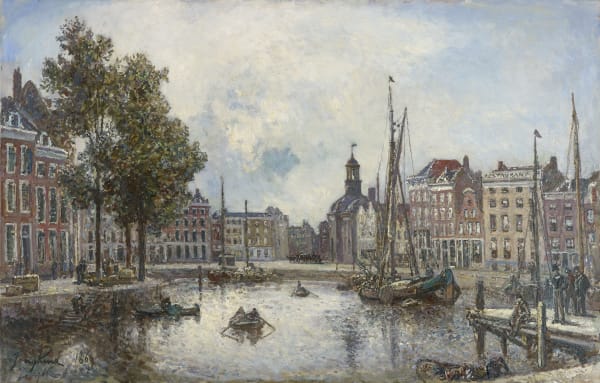Johan-Barthold Jongkind Dutch, 1819-1891
The Dutch painter Johan Jongkind was considered one of the forerunners of the impressionist movement and often dubbed “The Father of Impressionism”.
He developed an idiosyncratic style that earned him the admiration of Edouard Manet, Claude Monet, Camille Pissarro and Eugène Boudin.
Born in Latrop, in the Netherlands, the artist spent time in Vlaardingen and Massluis where he was often found drawing.
Jongkind initially studied under the well-known landscape painter Andreas Schelfhout (1797-1890) at the Academy of Art (The Hague). His artwork from this period reveals an attachment to the Dutch 17th-century landscape painters, seen firstly in the composition of his painting and secondly, in the choice of his subjects.
Upon arrival in Paris, in 1844, Jongkind continued his artistic education, meeting fellow pupils including Thomas Couture, Théodore Rousseau and Eugène Boudin. Taught by Eugène Isabey, Jongkind developed an interest in the river and its banks We see this fondness grow as a recurrent subject in his artwork.
Isabey recognised Jongkind’s talent for seascapes and subsequently, in 1850, took him on a tour of Normandy and Brittany. It was around this time that he met the fellow artists Charles-François Daubigny, Nadar, and the art critic and poet Charles Baudelaire.
However, as a result of financial issues, the harsh criticism he received for experimental techniques, and a troubled mind, Jongkind returned to Holland.
As a result of this hardship, Jongkind’s return in 1855, marked the beginning of a difficult five year long period. This was only occasionally relieved – with the help of Camille Corot and Daubigny – by the sales of his works in Paris during 1861.
Jongkind returned to Paris in the same year and received commercial success from this point onwards. Madame Fesser, his loyal companion, and he went on numerous trips to the coast where he was inspired to paint port scenes that were often exhibited at the Salon and which gained him great popularity. (do you mean…) With his long-time companion Madame Fesser, Jongkind spent much time at the coast, where he was inspired to paint port scenes. These coastal paintings were popular, since they were often exhibited at the Salon.
Jongkind combined a fresh and intuitive vision, whilst assimilating European landscape tradition. Through a precise method, the artist, endowed with marvellous visual memory, often executed watercolours ahead of the studio paintings.
The artist developed a subtle technique, a shimmering style which translated the energetic and emotional character of the scenes he depicted.
This new approach to landscape painting significantly influenced the superseding impressionist artists.
For Boudin, "Jongkind was beginning to get people to swallow a painting, the skin of which, rather tough, covered an excellent and most tasty fruit." Regarding the watercolours, Boudin claimed, "This is made of nothing, and yet the fluidity of the sky and clouds are transposed with unimaginable accuracy". It seems apt then, that Monet was later to write "Jongkind had me show my sketches, he invited me to come and work with him, explained the manner and reasons of his painting and, completing the teaching I had received by Boudin, he became henceforth my true master. It is to him I owe the definitive education of my eye…"
The artist’s work is included in major global museum collections such as: Musee d’Orsay, Paris; Rijksmuseum, Amsterdam; Metropolitan Museum of Art, New York; Philadelphia Museum of Art, Philadelphia; Courtauld Institute of Art, London; Beaux Arts National Museum, Rio de Janeiro; National Gallery of Art, Washington D.C.
-
 Johan-Barthold JongkindLe Quai des Célestins, 1869Oil on canvas41 x 66 cm
Johan-Barthold JongkindLe Quai des Célestins, 1869Oil on canvas41 x 66 cm
16 1/8 x 26 inchesSigned and dated lower left Jongkind 1869 -
 Johan-Barthold JongkindBateaux en rade de Honfleur, 1865Watercolour and charcoal on paper31 x 52 cm
Johan-Barthold JongkindBateaux en rade de Honfleur, 1865Watercolour and charcoal on paper31 x 52 cm
12 ¼ x 20 ¼ inchesSigned lower centre Jongkind Dated and located lower right Honfl 12 Sept 65
-

TEFAF Maastricht 2023
11 - 19 Mar 2023Join us at TEFAF Maastricht 2023, where we are exhibiting a selection of 19th and 20th-century French paintings and works on paper, including works by Eugène Boudin, Gustave Courbet, Charles-François...Read more -

TEFAF Maastricht 2019
16 - 24 Mar 2019For TEFAF Maastricht 2019, Stoppenbach & Delestre is pleased to present a selection of 19th & 20th-century French artworks such as works by Louis Valtat, Henry Moret, Gustave Loiseau, Armand...Read more -

Still Lifes and Landscapes from the 19th & 20th century
5 Oct - 17 Nov 2018Stoppenbach & Delestre is delighted to present a selection of works revolving around the thematic of Still Lifes & Landscapes in the 19th & 20th century. The exhibition features works...Read more





